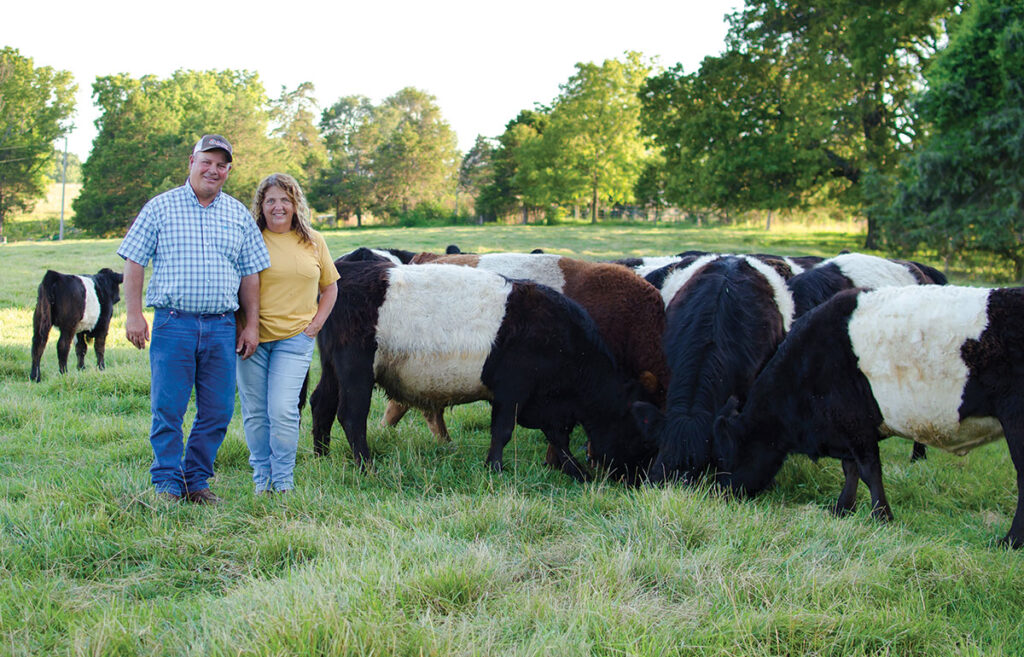
Loy and Mary Beth Galloway find their niche with Belted Galloways
CLEVER, MO. – Dotting a hillside of Crane, Mo you’ll find Loy and Mary Galloway’s pride and joy: a herd of Belted Galloways.
Resembling a furry Oreo on four legs with their characteristic white belt pattern sandwiched between shades of black, red or dun, the Belted Galloway, or Beltie as they are affectionately called in the business date back to the 16th century. They originated in the former Galloway region of Scotland where the terrain was rough and the countryside required whatever survived there to be hardy and rugged. After a rough go for the breed in the early 2000s, where many cattle were wiped from the British countryside by the foot-and-mouth disease epidemic, the Belted Galloway is currently listed as a “recovering breed” by the American Livestock Breeds Conservancy.
If the coincidental name likeness wasn’t enough, the long and interesting history played a huge role in what drew Loy and Mary to the breed. They are a perfect fit for Southwest Missouri’s hills and rocky terrain; they are also incredibly easy keepers. Requiring very little veterinary care and their high parasite resistance, Loy and Mary do very little to keep their herd healthy. Basic vaccinations for the area and fly control are a top priority.
“They do need a little water in the summertime. Maybe a bit more than other breeds, but a small pond would do,” Loy recommended. In addition to their water needs, Mary enjoys giving them a quick brushing to keep tangles and burrs from their long locks, but it isn’t a necessity.
The Galloways run 25 to 30 registered head, which includes one working bull and about 12 cows on roughly 60 acres split over a few tracts. Because Loy and Mary have full-time jobs off the farm, Loy works for Early Bird Feed and Fertilizer and Mary teaches first grade at Crane R-3 School, they chose a breed whose temperament was docile and gentle. It was important to them that they were able to work their herd themselves. “Their gentleness is a huge plus in our situation since it is just the two of us to do all the work,” Mary said. Aside from the occasional advice from neighboring farmers, the hard work is shared between the two. “Mary there, she’s my partner,” Loy said.
When it comes to feeding, the Beltie breed has an excellent drive to forage, more so than some other breeds. They do well on a little brushy terrain, but prefer grass if available. Mary and Loy rotate their herd throughout the year where pasture is readily available. In the cold months, they feed good grass hay they purchased in the summer. They also feed a little bit of grain but are careful not to feed too much.
“God has blessed us greatly, and we believe that it is a blessing to have this land and these cattle. Farming is something we do together and enjoy. As long as we are able and as long as we are enjoying ourselves, we will probably keep on with our little farm of Belties.”
— Mary Beth Galloway
“This keeps them gentle and makes them come to us more easily,” Mary explained. Over-graining a Beltie, especially at finishing, will result in a fatty beef. Belties are notorious for their exceptionally lean and flavorful meat. The meat is tender, juicy, low in saturated fat and high in Omega-3. The Galloways say they have little trouble selling their beef. Most of the sales of their halves or quarters go quickly by word of mouth. They often have a list of people waiting to fill their freezer.
When it comes to marketing sales of their herd, Mary runs the farm’s Facebook page, LMG Belted Galloway. Her pictures are marketing enough when they have calves hit the ground. In addition to her Facebook page, Mary also lists their stock on various Belted Galloway Enthusiast groups on Facebook, “Our goal is to keep a few cattle, raise enough beef for our family, and sell a few along the way. We have been able to sell our Belties locally and with other breeders across the country. There is a network of Beltie breeders online and a lot of interest from people wanting to get into the breed.”
As in most heritage livestock breeds, a downfall of the Belted Galloway is the time it takes to reach maturity. Typically, Loy waits until year two to send a steer to the butcher which averages a weight of about 900 pounds. Additionally, he prefers a heifer to be 2 before exposing her to a bull.
“Of course, there are many opinions on when to breed,” Mary explained. “We have just been successful waiting a little longer so we continue this practice.” The Galloways prefer to use a bull over AI and have had success with breeding consistency. “We expose our cows/heifers to a bull so we have a few calves in the spring and a few in the fall. We like to avoid the hottest and coldest months.” Rarely do they choose to raise any bull calves; most are castrated and raised for beef.
Loy and Mary truly enjoy working with their Belted Galloway herd.
“God has blessed us greatly, and we believe that it is a blessing to have this land and these cattle,” Mary added.“Farming is something we do together and enjoy. As long as we are able and as long as we are enjoying ourselves, we will probably keep on with our little farm of Belties.”







